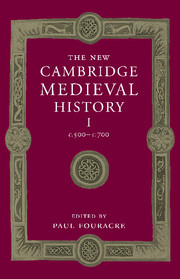Book contents
- Frontmatter
- Introduction: the history of Europe 500–700
- 1 The later Roman Empire
- 2 The Barbarian invasions
- 3 The sources and their interpretation
- PART I THE SIXTH CENTURY
- 4 The Eastern Empire in the sixth century
- 5 The Byzantines in the West in the sixth century
- 6 Ostrogothic Italy and the Lombard invasions
- 7 The formation of the Sueve and Visigothic kingdoms in Spain
- 8 Merovingian Gaul and the Frankish conquests
- 9 The Celtic kingdoms
- 10 The earliest Anglo-Saxon kingdoms
- PART II THE SEVENTH CENTURY
- PART III THEMES AND PROBLEMS
- List of Primary sources
- Bibliography of secondary works arranged by chapter
- Index
- Frontispiece"
- Plate section"
- Map 3 Gaul/Francia in the sixth and seventh centuries"
- References
9 - The Celtic kingdoms
from PART I - THE SIXTH CENTURY
Published online by Cambridge University Press: 28 March 2008
- Frontmatter
- Introduction: the history of Europe 500–700
- 1 The later Roman Empire
- 2 The Barbarian invasions
- 3 The sources and their interpretation
- PART I THE SIXTH CENTURY
- 4 The Eastern Empire in the sixth century
- 5 The Byzantines in the West in the sixth century
- 6 Ostrogothic Italy and the Lombard invasions
- 7 The formation of the Sueve and Visigothic kingdoms in Spain
- 8 Merovingian Gaul and the Frankish conquests
- 9 The Celtic kingdoms
- 10 The earliest Anglo-Saxon kingdoms
- PART II THE SEVENTH CENTURY
- PART III THEMES AND PROBLEMS
- List of Primary sources
- Bibliography of secondary works arranged by chapter
- Index
- Frontispiece"
- Plate section"
- Map 3 Gaul/Francia in the sixth and seventh centuries"
- References
Summary
Ireland, Scotland, the Isle of Man, Wales, south-western Britain (Cornwall and Devon) and Brittany were the principal Celtic countries in the sixth and seventh centuries, although some other parts of western Europe still had a Celtic vernacular language at that time. This was certainly the case in north-west Spain and in parts of England, but may also have been so in central France. These Celtic countries are defined linguistically: they are the areas in which Celtic languages were normally and primarily used. The languages themselves fall into two broad groups, Brittonic (a type of P-Celtic) and Goidelic (Q-Celtic), the language groups of Britain and Ireland respectively. During this period some distinctions between the constituent Brittonic languages developed, but these were relatively slight and did not prevent communication across the group; Primitive Cumbric, therefore, the language of southern Scotland and northwest England, was little different from Primitive Welsh, which was itself little different from Primitive Cornish. Primitive Breton was at this stage indistinguishable from Cornish, although it remains a matter of debate whether Breton was introduced to north-west France by immigrants from Britain or whether some dialects were the natural (or reinforced or brittonised) continuation of the P-Celtic Gaulish that had once been spoken over much of western Europe. The main Pictish language, the language of eastern and northern Scotland, appears to have been a rather different form of P-Celtic (possibly closer to Gaulish) and may or may not have been immediately intelligible to speakers of Cumbric to the south. Though we might expect some regional differences within it, speakers of the Goidelic group were largely confined to Ireland and spoke a single Primitive Irish.
- Type
- Chapter
- Information
- The New Cambridge Medieval History , pp. 232 - 262Publisher: Cambridge University PressPrint publication year: 2005
References
- 1
- Cited by



